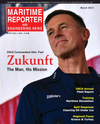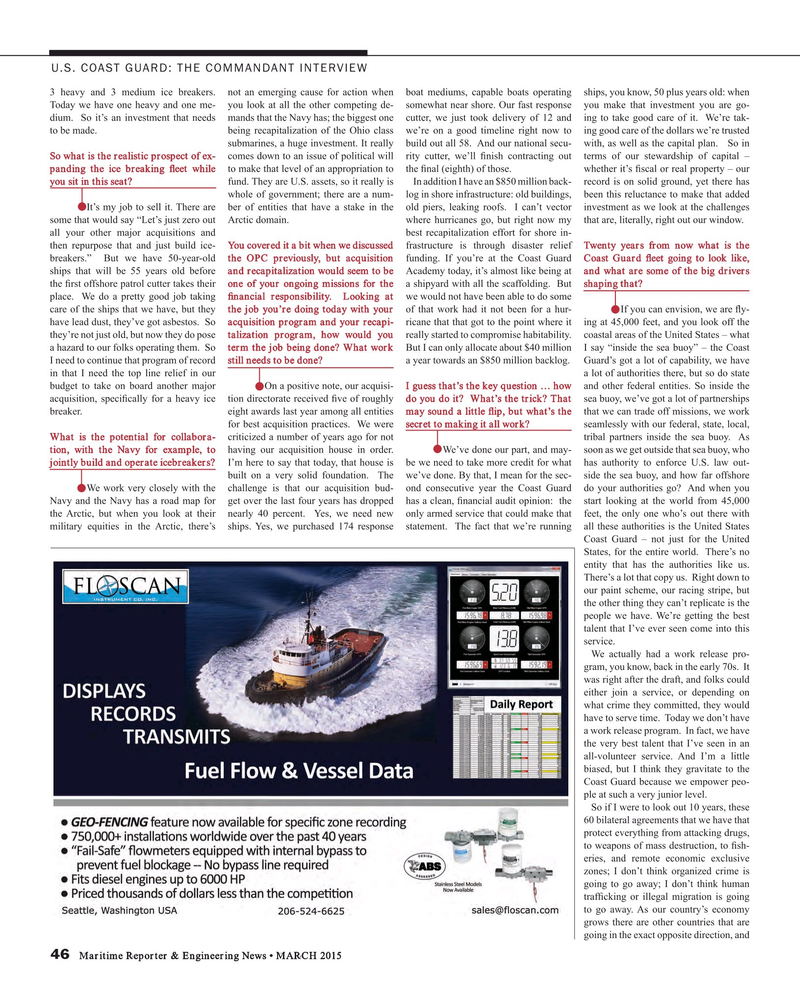
Page 46: of Maritime Reporter Magazine (March 2015)
U.S. Coast Guard Annual
Read this page in Pdf, Flash or Html5 edition of March 2015 Maritime Reporter Magazine
U.S. COAST GUARD: THE COMMANDANT INTERVIEW 3 heavy and 3 medium ice breakers. not an emerging cause for action when boat mediums, capable boats operating ships, you know, 50 plus years old: when
Today we have one heavy and one me- you look at all the other competing de- somewhat near shore. Our fast response you make that investment you are go- dium. So it’s an investment that needs mands that the Navy has; the biggest one cutter, we just took delivery of 12 and ing to take good care of it. We’re tak- to be made. being recapitalization of the Ohio class we’re on a good timeline right now to ing good care of the dollars we’re trusted submarines, a huge investment. It really build out all 58. And our national secu- with, as well as the capital plan. So in
So what is the realistic prospect of ex- comes down to an issue of political will rity cutter, we’ll ? nish contracting out terms of our stewardship of capital – panding the ice breaking ? eet while to make that level of an appropriation to the ? nal (eighth) of those. whether it’s ? scal or real property – our you sit in this seat? fund. They are U.S. assets, so it really is In addition I have an $850 million back- record is on solid ground, yet there has whole of government; there are a num- log in shore infrastructure: old buildings, been this reluctance to make that added It’s my job to sell it. There are ber of entities that have a stake in the old piers, leaking roofs. I can’t vector investment as we look at the challenges some that would say “Let’s just zero out Arctic domain. where hurricanes go, but right now my that are, literally, right out our window.
all your other major acquisitions and best recapitalization effort for shore in- then repurpose that and just build ice- You covered it a bit when we discussed frastructure is through disaster relief Twenty years from now what is the breakers.” But we have 50-year-old the OPC previously, but acquisition funding. If you’re at the Coast Guard Coast Guard ? eet going to look like, ships that will be 55 years old before and recapitalization would seem to be Academy today, it’s almost like being at and what are some of the big drivers the ? rst offshore patrol cutter takes their one of your ongoing missions for the a shipyard with all the scaffolding. But shaping that?
place. We do a pretty good job taking ? nancial responsibility. Looking at we would not have been able to do some care of the ships that we have, but they the job you’re doing today with your of that work had it not been for a hur- If you can envision, we are ? y- have lead dust, they’ve got asbestos. So acquisition program and your recapi- ricane that that got to the point where it ing at 45,000 feet, and you look off the they’re not just old, but now they do pose talization program, how would you really started to compromise habitability. coastal areas of the United States – what a hazard to our folks operating them. So term the job being done? What work But I can only allocate about $40 million I say “inside the sea buoy” – the Coast
I need to continue that program of record still needs to be done? a year towards an $850 million backlog. Guard’s got a lot of capability, we have in that I need the top line relief in our a lot of authorities there, but so do state budget to take on board another major On a positive note, our acquisi- I guess that’s the key question … how and other federal entities. So inside the acquisition, speci? cally for a heavy ice tion directorate received ? ve of roughly do you do it? What’s the trick? That sea buoy, we’ve got a lot of partnerships breaker. eight awards last year among all entities may sound a little ? ip, but what’s the that we can trade off missions, we work for best acquisition practices. We were secret to making it all work? seamlessly with our federal, state, local,
What is the potential for collabora- criticized a number of years ago for not tribal partners inside the sea buoy. As tion, with the Navy for example, to having our acquisition house in order. We’ve done our part, and may- soon as we get outside that sea buoy, who jointly build and operate icebreakers? I’m here to say that today, that house is be we need to take more credit for what has authority to enforce U.S. law out- built on a very solid foundation. The we’ve done. By that, I mean for the sec- side the sea buoy, and how far offshore We work very closely with the challenge is that our acquisition bud- ond consecutive year the Coast Guard do your authorities go? And when you
Navy and the Navy has a road map for get over the last four years has dropped has a clean, ? nancial audit opinion: the start looking at the world from 45,000 the Arctic, but when you look at their nearly 40 percent. Yes, we need new only armed service that could make that feet, the only one who’s out there with military equities in the Arctic, there’s ships. Yes, we purchased 174 response statement. The fact that we’re running all these authorities is the United States
Coast Guard – not just for the United
States, for the entire world. There’s no entity that has the authorities like us.
There’s a lot that copy us. Right down to our paint scheme, our racing stripe, but the other thing they can’t replicate is the people we have. We’re getting the best talent that I’ve ever seen come into this service.
We actually had a work release pro- gram, you know, back in the early 70s. It was right after the draft, and folks could either join a service, or depending on what crime they committed, they would have to serve time. Today we don’t have a work release program. In fact, we have the very best talent that I’ve seen in an all-volunteer service. And I’m a little biased, but I think they gravitate to the
Coast Guard because we empower peo- ple at such a very junior level.
So if I were to look out 10 years, these 60 bilateral agreements that we have that protect everything from attacking drugs, to weapons of mass destruction, to ? sh- eries, and remote economic exclusive zones; I don’t think organized crime is going to go away; I don’t think human traf? cking or illegal migration is going to go away. As our country’s economy grows there are other countries that are going in the exact opposite direction, and 46 Maritime Reporter & Engineering News • MARCH 2015
MR #3 (42-49).indd 46 MR #3 (42-49).indd 46 3/3/2015 2:41:07 PM3/3/2015 2:41:07 PM

 45
45

 47
47
